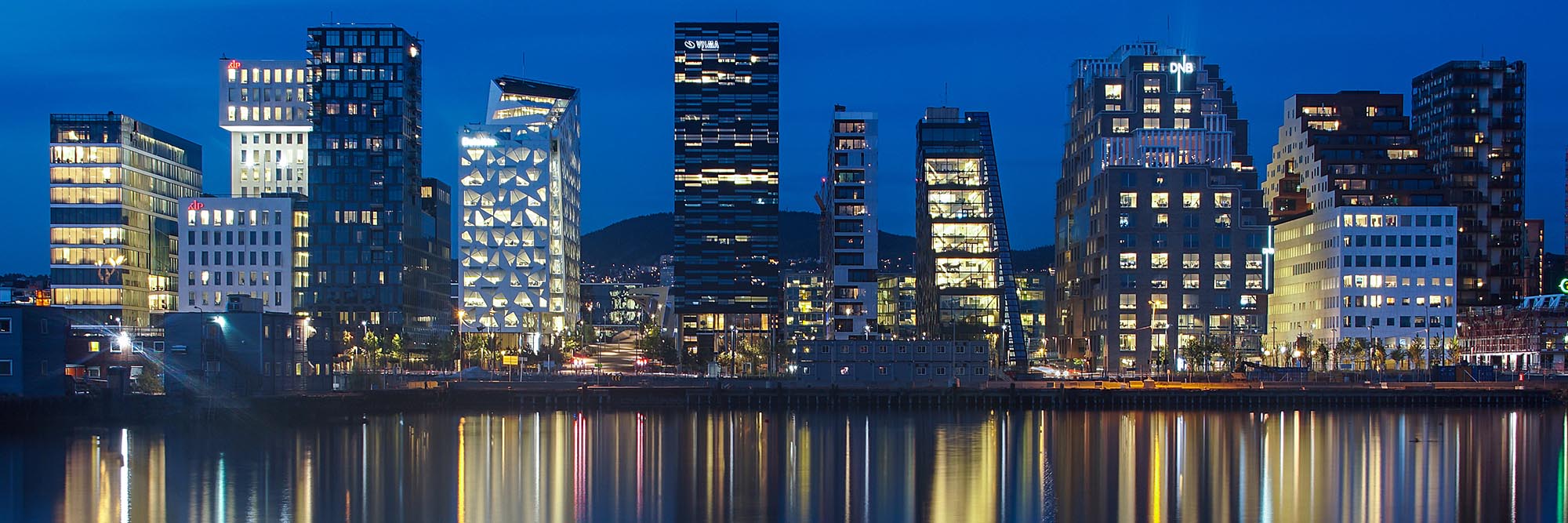Oslo is the beautiful capital city of Norway and a fascinating destination to visit. Rife with greenery and Viking history, Oslo takes a top spot on many travellers’ Norwegian trips.
Although the city is one of the world’s largest capitals in terms of area, only 20 percent of the land has been developed. The rest consists of parks, hills, protected forests, and lakes. While many visitors like to hop on buses, trains, and boats to sightsee Oslo, walking tours are mostly recommended.

The beautiful view of Oslo’s harbor
Walking tours generally cover the historical or cultural sites of a place. You are either accompanied by a guide or can take a self-guided tour. These tours allow you to view landscapes from a closer distance, learn more about the culture, and lower your impact on the environment.
Walking tours are known to be the ultimate in slow travel and allow you to experience each attraction leisurely. The Oslo walking tour is part of our specially curated tour of 11 Scandinavian capitals.
Here are seven landmarks you need to see on a typical Oslo walking tour:
1. Akershus Fortress
The Akershus Castle and Fortress were built in the 13th century. Today, it is one of the best places to learn more about Oslo’s history.
You can wander around the ramparts and grounds of Akershus at your own pace before taking in the stunning harbour views. You can also visit the quaint chapel, which houses the remains of the original medieval castle.

Akershus Fortress in the evening
The Museum of Norwegian Resistance is located in Akershus, where you can spend a few hours learning about the German occupation. If you still have time, you can also visit the Norwegian Armed Forces Museums located in Old Arsenal, Oslo. It is a fascinating museum that displays numerous weapons and exhibits from the Norwegian forces over the centuries.
2. Opera house
Oslo Opera House is home to the Norwegian National Opera and Ballet as well as the National Opera Theatre. The beautiful and unique design of this opera house appears as if it slips right into the city’s harbour due to its angled exterior surfaces.
One of the largest buildings constructed in Norway covers itself in Italian marble and white granite.

The extraordinary Opera House of Oslo
While many tourist sites around the world have restrictions, this opera house is different. You can stroll on the building’s rooftop and enjoy gorgeous views of the city. Visitors can also participate in various interesting public programs.
The month-long Festival of Chamber Music occurs in August and attracts acclaimed musicians from all over the world. You can enjoy other mesmerising stages and plays in the Opera House during an average day in Oslo.
3. Royal Palace
The Norwegian royal palace stands high up at the northwest end and was constructed in the first half of the 19th century. The 173-room building is open to the public during the summer season.
You can tour significant rooms in the palace, like the white parlour, great wall, mirror hall, and others. The grounds of the royal palace are accessible to visitors, and you can take a look at the gardens or watch the regular changing of the guards.

The colossal Royal Palace
The Norwegian Nobel Institute, where they present the prestigious Nobel Peace Prize, awaits you if you venture towards the south of the palace.
4. Vigeland Sculpture Park
Located inside the famous Frogner Park, Vigeland Sculpture Park is quite iconic and popular among tourists. This one-of-a-kind sculpture park is home to Gustav Vigeland’s handiwork and contains more than 200 sculptures in granite, bronze, and wrought iron.

One of the sculptures featured in Vigeland Sculpture Park
The sculptures in the park are a tribute to the intricacy of mankind. One of the themed sculptures centres around the monolith. A skilled artisan carved 121 human figures climbing around and holding onto one another on a gigantic stone block. Each figure symbolizes the stages of life.
This significant park not only celebrates Vigeland’s art but also appreciates the range of emotions a human goes through.
After you complete your trip to the sculpture park, you can enjoy a picnic among the greenery in Frogner Park. Here, you can also find an enormous rose garden, the nation’s largest playground, the Oslo City Museum, and Vigeland’s Museum.
5. The Viking Ship Museum
Norway’s Viking past cannot be missed during your visit to the country. While there are many museums dedicated to its myths and folklore, the Viking Ship Museum is one of the best. It exhibits three well-preserved historic vessels built in the 9th century, one of which is the 21-metre-long Oseberg ship.

A treasured antique ship displayed in the museum
The Oseberg ship is an impressively decorated vessel and has an interesting story behind it. Other ships in the museum include the Gokstad and Tune ships. The museum plays a film known as ‘Viking’s Alive, which demonstrates how these huge vessels were made during that period.
Other exhibits focus on and explore a Viking’s life on the seas.
6. City Hall
Oslo’s tremendous city hall is one of the city’s greatest landmarks. The towering square building has two towers, one of which boasts a gigantic clock face. Moreover, one of the towers has 38 bells that can be heard throughout the harbour area when chimed.

Oslo’s City Hall in the winter
Surrounded by sculptures, the city hall showcases the country’s political and cultural sides. Numerous studios and galleries call it home, and it is considered an architectural gem. During the walking tour, you can admire its interior and exterior, which famous Norwegian artists constructed.
7. Oslo Cathedral
The Norwegian royal family and the Norwegian government use Oslo Cathedral for public events, although it dates back to 1697 and has undergone numerous rebuilds and renovations.

Oslo’s Cathedral in the daylight
There are several notable features of the cathedral, including the intricately decorated doorways, ceiling paintings, the altar, and the stained glass. These works belong to the most renowned artists known.
After exploring the cathedral, you can visit the Oslo Bazaar, which is occupied by cafes, galleries, and antique dealers.
Oslo is an ideal place to explore and familiarise yourself with its dynamic culture. Don’t forget to visit these places during your walking tour of the city.
If you loved reading this story, then subscribe to our blog here (it will ask to verify your email) to get inspiring travel stories and trivia delivered to your email. Stories about wildlife trivia, cultural experiences, curated luxury hotel lists, underrated places to travel, polar journeys and much more.

The content team at Wild Voyager. We are passionate to bring you travel stories and unique experiences from around the world. Spread the love and feel free to share these stories.











